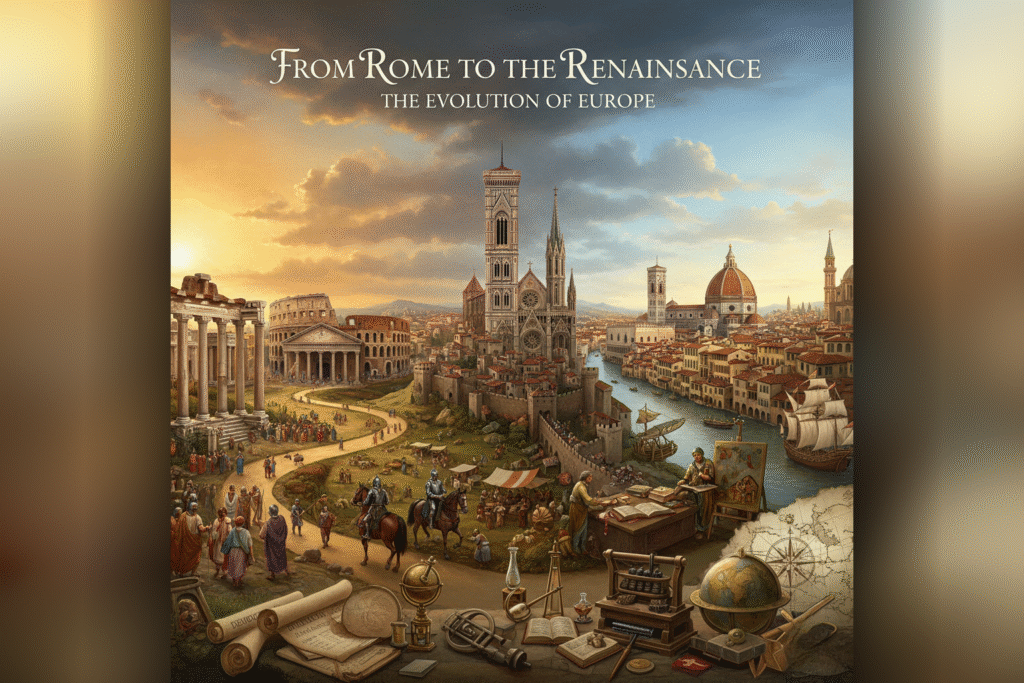Title: From Rome to the Renaissance: The Evolution of Europe
People often compare Europes history to a long epic story. It features heroes and villains along with love and betrayal and plenty of battles. One small continent managed to influence the entire world in major ways. The tale covers the growth of great empires and the start of art and science. Europes past focuses on people and ideas that truly transformed things.
Go back several thousand years. Before grand castles appeared and cities grew crowded, Europe housed tribes and farmers in small communities. Ancient Greeks and Romans arrived next. They laid the groundwork for Western civilization as we know it. Greece contributed democracy and philosophy and theater. It also brought many fascinating myths. Rome provided roads and legal systems. Its empire covered nearly all of Europe.
The Roman Empire linked places like a vast network in ancient times. Still, nothing endures forever. By the fifth century, Rome collapsed. Internal problems and constant invasions brought it down. The period that followed became known as the Middle Ages. It turns out this era was not quite as gloomy as some believe.
Europe began to recover during the Middle Ages. Plagues and wars and crusades made life tough. Progress happened anyway. Feudalism developed with kings and knights and peasants each in their roles. The system functioned in its own way. The Catholic Church gained great influence. It shaped beliefs and laws and even political matters. Cathedrals towered over villages like massive stone offerings reaching upward.
Europe kept changing bit by bit. Trade paths expanded over time. Ideas flowed in from the Middle East and Africa via traders and explorers. Folks started challenging traditional views. Then the Renaissance emerged like dawn after darkness.
Renaissance translates to rebirth. That describes it well. It began in Italy during the fourteenth century. Europe revived interest in art and science and human potential. Figures such as Leonardo da Vinci and Michelangelo and Galileo stood out. They dreamed big and altered our view of the world. Places like Florence and Venice and Rome turned into hubs of culture and new ideas. Art shifted from mere ornament to something full of feeling and expression and even scientific elements.
Gutenberg created the printing press in the 1400s. Books grew more available after that. Knowledge reached beyond the wealthy and elite. Readers could access it directly. This shift ignited major shifts in religion and science and government. Individuals learned to think independently.
Europe moved into the Age of Exploration next. Countries including Spain and Portugal and England and France ventured over seas. They found new territories and at times took control of them. Adventure defined the era. Tragedy marked it too. Empires grew quickly. Cultural sharing and worldwide commerce resulted. Colonization and mistreatment and widespread hardship came along as well.
Europe entered modern times after experiencing empires and uprisings and conflicts and renewals and artistic and industrial advances. From the powerful armies of ancient Rome to the thoughtful creators of the Renaissance, the continents path involved ongoing shifts.
A walk through a European city today carries echoes of the past. Cobblestone paths where thinkers once strolled remain. Cathedrals built over generations endure. Artwork continues to communicate strongly. Europes narrative blends its rich heritage with the ongoing now.
History shows that Europe rarely remains unchanged. It keeps developing. That pattern holds from Rome through the Renaissance and into the future.


